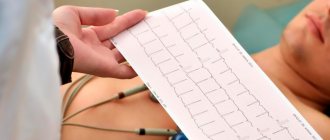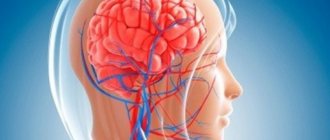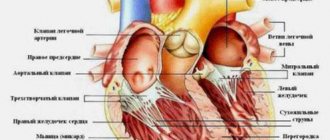- Home /
- Branches /
- Therapy /
- Diseases of the cardiovascular system
11/03/2021 The article was checked by general practitioner Mardanova O.A. , is for general informational purposes only and does not replace specialist advice.
For recommendations on diagnosis and treatment, consultation with a doctor is necessary. According to statistics from the World Health Organization, cardiovascular diseases are the most common cause of death on Earth. Thus, timely consultation with a doctor, correct diagnosis, effective treatment and constant prevention are especially important when it comes to the cardiovascular system.
It is generally accepted that the main sign of any disease of the cardiovascular system is chest pain. However, this is not entirely true: chest pain can also be felt by a healthy person, who has an easily excitable nervous system. At the same time, cardiac pathology can manifest itself in a completely different way, for example, an increase in blood pressure, in which the main complaint will be a general poor condition.
That is why, if there is any change in your health, we recommend contacting a therapist at the Yauza Clinical Hospital. Doctors at the therapy department will make a preliminary diagnosis and refer you to the necessary examinations and consultations with specialists.
Causes of diseases of the cardiovascular system
Cardiovascular disease is caused by a number of reasons, the most common of which are:
- atherosclerosis (formation of cholesterol plaques on the inner wall of blood vessels). This leads to a narrowing of the lumen of the vessel, and sometimes to its blockage, and an increase in blood pressure
- congenital malformations of the heart and blood vessels
- obesity
- lipid metabolism disorder
- disruption of the endocrine system
- infections (streptococcus, enterococcus and others)
- sedentary lifestyle
- stress
- diseases of other organs and systems (for example, diabetes, kidney disease and others)
- heredity
Major diseases of the cardiovascular system
The most common pathologies of the cardiovascular system include the following.
Hypertension is an increased level of blood pressure. The disease may be asymptomatic, or may be accompanied by such phenomena as dizziness, headache, tinnitus, flashing spots before the eyes, nausea, weakness, and insomnia.
Arrhythmia is a heart rhythm disorder. The main symptoms of arrhythmia include irregular, very rapid or slow heartbeat, dizziness, near fainting, and chest pain. In some cases, you may not feel any signs of abnormal heart rhythm.
Coronary heart disease (CHD) is a pathology in which myocardial damage occurs due to insufficient blood supply. Most often, symptoms of IHD appear during physical activity: chest pain, a feeling of lack of air, shortness of breath, swelling, interruptions in heart function, arrhythmia.
Heart failure is a complex of disorders caused primarily by a decrease in the contractility of the heart muscle. Symptoms of heart failure largely depend on which part of the heart is affected. These include cyanosis, shortness of breath, hemoptysis, rapid heartbeat, edema, and enlarged liver.
Acquired heart defects are diseases associated with disorders of the valvular apparatus of the heart and great vessels. The main manifestations are pain in the heart, shortness of breath, swelling, rapid heartbeat, cough, hemoptysis, chest pain during physical activity, dizziness, fainting.
DISEASES OF THE CIRCULATORY SYSTEM
Symptoms. Among other causes of mortality among the population,
diseases of the body's circulatory system occupy a leading place. With such diseases, pathologies are observed both in the vessels and in the patient’s heart. A person in this condition permanently loses the ability to work. Patients of different ages suffer from similar ailments; they manifest themselves equally in both men and women. Since there are a lot of such diseases, some of them more often affect the female body, and some - the male body.
FUNCTIONS AND STRUCTURE The circulatory system consists of the heart, as the main organ, arteries, veins and capillaries. These organs make up two circles of blood circulation. They are called the large circle and the small one. Such circles are created from vessels that come out of the heart. Moreover, both circles are closed, that is, blood circulates inside each of them. The pulmonary circulation of the human circulation consists of the pulmonary veins and the pulmonary trunk. The large circle is the aorta, emerging from the cavity of the left cardiac ventricle. The aorta transports blood from the heart to large vessels that go to the person’s head, limbs and entire torso. From large vessels small ones are formed, these are intraorgan arteries, which also pass into arterioles, as well as into capillaries. Capillaries are the smallest human vessels, which is why they ensure the metabolic process between blood and tissues. They unite into postcapillary venules, merging together, and veins emerge from them. Initially they are intraorgan, and then extraorganic. The blood, having passed through the entire human circulatory system, returns to the right atrium, passing through the upper and lower veins. The functions of the circulatory system are to fully provide the human body with all the necessary substances for nutrition. The blood carries these substances to all tissues, removes from the body harmful products that arise during the metabolic process, and also transports them for excretion or processing. The human circulatory system is also capable of transporting metabolic products between internal organs. Diseases of the circulatory system are the main cause of disability and mortality among the population of many countries. Heart and vascular diseases are very common among people of working age, thereby causing significant economic damage. ATHEROSCLEROSIS Atherosclerosis is a pathological process in which fats are deposited in the walls of arteries, leading to the formation of connective tissue (atherosclerotic plaque) and narrowing of the lumen of blood vessels. “Favorite” places for atherosclerosis are the aorta, coronary, femoral, popliteal, carotid and cerebral arteries. Manifestations of atherosclerosis depend on the location of the atherosclerotic process. When the coronary vessels are affected, atherosclerosis can manifest as angina pectoris, myocardial infarction, or even sudden cardiac death. If the arteries in the brain are affected, a stroke may occur. The appearance of atherosclerotic plaques in the arteries of the lower extremities can manifest as intermittent claudication or gangrene. CORONARY HEART DISEASE Coronary heart disease is a disease in which the delivery of oxygen to the heart muscle does not meet its needs, as a result of which the functioning of the heart is disrupted. Most often, this pathology occurs against the background of an atherosclerotic process. The most common clinical forms of coronary heart disease include angina pectoris, myocardial infarction and sudden cardiac death. Angina pectoris (angina pectoris) is manifested by attacks of pain or discomfort in the heart due to insufficient oxygen supply to the cells of the heart muscle. Despite the pronounced discrepancy between the blood flow to the myocardium and its need for oxygen, necrosis of the heart muscle (necrosis) does not occur. During myocardial infarction, oxygen starvation of the heart muscle suddenly occurs, which leads to myocardial necrosis. Sudden cardiac death occurs due to an abnormal heart rhythm (ventricular flutter) or cardiac arrest. ARTERIAL HYPERTENSION Arterial hypertension is an increase in blood pressure. This condition is classified when the systolic blood pressure is greater than (or equal to) 140 mm Hg. Art. and/or diastolic pressure is 90 mm Hg. Art. or higher. In order for blood pressure measurement data to be considered reliable, it is necessary to carry out the procedure three times, in a calm environment. Arterial hypertension can be primary (hypertension) and symptomatic. Hypertension is diagnosed if all other possible disorders of various organs and systems that can cause an increase in blood pressure are excluded. Symptomatic arterial hypertension includes increased blood pressure due to kidney damage, endocrine disorders (pheochromocytoma, primary hyperaldosteronism, hypothyroidism or thyrotoxicosis), taking certain medications (contraceptives, antidepressants, non-steroidal anti-inflammatory drugs, glucocorticoids), and chronic alcohol abuse. HYPOTENSION Arterial hypotension is a simultaneous decrease in both systolic and diastolic pressure below normal levels. The causes of arterial hypotension may be disturbances in the regulation of vascular tone, some diseases of the circulatory system (myocardial infarction, acute myocarditis, pericarditis), respiratory organs (spontaneous pneumothorax, status asthmaticus), endocrine pathologies (hypothyroidism, Addison's disease), anemia, blood cancer. syncope Syncope (fainting) is a sudden short-term loss of consciousness, accompanied by weakness of all muscle groups, a drop in blood pressure and shallow breathing. Fainting develops as a result of acute transient cerebral circulatory failure. VSD Neurocirculatory dystonia (vegetative-vascular dystonia) is a functional disease of the cardiovascular system, which is based on disturbances of nervous and hormonal regulation, manifested by various symptoms. In most cases, signs of neurocirculatory dystonia appear or worsen under stressful conditions. DISEASES OF THE INNER LINING OF THE HEART (ENDOCARDIUM), CARDIAC MUSCLE (MYOCARDIUM) AND THE PERICARDIA (PERICARDIA) Infectious endocarditis is an inflammation of the inner lining of the heart caused by microbes, leading to the destruction of the heart valves and disruption of their function. In infective endocarditis, bacteria become fixed on the inner lining of the heart and multiply there, causing disruption of the integrity of the valve walls. Pericarditis is inflammation of the pericardial sac. Pericarditis can be dry (fibrin threads are deposited on the pericardium) and exudative (effusion forms in the pericardial cavity). When a large amount of fluid accumulates in the cavity of the pericardial sac, cardiac tamponade occurs. This condition leads to a significant limitation in the filling of the ventricles and atria, stagnation of blood in the veins of the systemic circulation and can cause complete cessation of blood circulation. Cardiomyopathies (myocardial dystrophies) are a group of primary lesions of the heart muscle that cause dysfunction of the heart. Cardiomyopathy is diagnosed if it is possible to exclude diseases of the coronary arteries, pericardial sac, valvular apparatus and arterial hypertension. The main types of cardiomyopathies are dilated, hypertrophic and restrictive. With dilated cardiomyopathy, the cavities of the heart expand and its contractile function is impaired. With hypertrophic cardiomyopathy, the walls of the left ventricle thicken and heart failure develops. With restrictive cardiomyopathy, the compliance of the ventricular wall is reduced. At the same time, the ability of the muscle cells of the ventricles to relax is impaired, with little change in the contractile function of the heart muscle, the absence of thickening of the wall of the ventricles or an increase in the size of their cavities. Myocarditis is an inflammation of the heart muscle, accompanied by a violation of its functions. The development of myocarditis can be caused by various infectious pathogens and non-infectious causes. HEART DEFECTS Heart defects are persistent pathologies in the structure of the heart that impair its function. Heart defects can be congenital or acquired. Birth defects are narrowing or insufficiency of the valves. Among the acquired heart defects, the most common are narrowing of the left atrioventricular valve (mitral stenosis), mitral valve insufficiency, aortic stenosis and aortic valve insufficiency. Examples of congenital heart defects are ventricular septal defect, atrial septal defect, patent ductus arteriosus. Also among congenital heart defects, coarctation of the aorta (local narrowing of the aortic lumen), pulmonary stenosis and some others may occur. HEART FAILURE Heart failure is a complication of many diseases of the heart and blood vessels. Heart failure is a pathology in which the work of the heart does not provide sufficient blood supply to the tissues they need for normal functioning. Based on the speed of development of symptoms, acute and chronic heart failure are distinguished. Acute heart failure can occur in the form of pulmonary edema or cardiogenic shock. Acute stagnation of blood in the pulmonary circulation leads to the development of pulmonary edema. If blood stagnates in the systemic circulation, cardiogenic shock may occur. Signs of chronic heart failure appear gradually. Chronic heart failure can be systolic or diastolic. Diastolic heart failure is a disorder of relaxation and filling of the left ventricle. With systolic failure, cardiac output (the amount of blood ejected by the heart into the vessels) decreases, and the passage of blood through the vessels of many organs and tissues is disrupted. HEART ARRHYTHMIAS In various diseases of the heart and other organs, the formation and conduction of impulses in the heart muscle may be disrupted. This group of pathologies is called arrhythmias. These include disturbances in the sequence and frequency of heart contractions. The following types of arrhythmias are distinguished: • If the heart beats at a rate of less than 60 beats per minute, then this condition is called sinus bradycardia. • If the heart rate exceeds 100 beats per minute, then it is sinus tachycardia. • If the conduction of nerve impulses through the conduction system of the heart is disrupted, then we are talking about heart blocks. • Extraordinary contraction of the heart is called extrasystole. • Very frequent and irregular contractions of the heart muscle cells are called fibrillation (atrial or ventricular). • Frequent, regular contractions of the muscle fibers of the atria or ventricles are called flutter.









